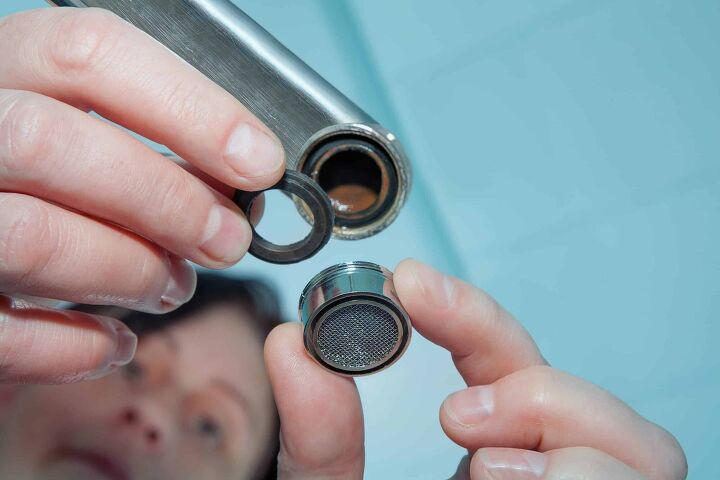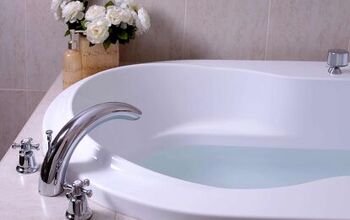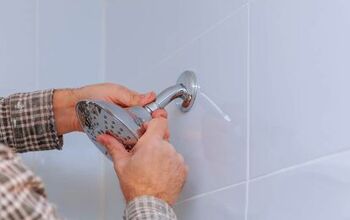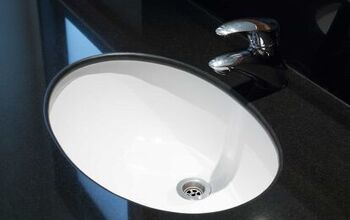How To Remove A Faucet Aerator That Is Stuck

A faucet aerator is a great way to conserve water usage and save a bit of money on your water bill. Faucet aerators mix air in with the water stream, saving up to an extra 16 gallons of water per day! It’s essential to clean your faucet aerator regularly and replace it every year to ensure continued efficiency.
To clean or replace your faucet aerator, you’ll need to remove it. If your faucet aerator is stuck, you can remove it by hand or using pliers or a rubber wrench. You can also heat it or use vinegar or WD-40 if the faucet aerator doesn’t come off with force.
Related Content: Faucet Aerator Sizes | Best Faucet Brands | Faucet Brands To Avoid
Do You Need to Hire a Plumber?
Get free, zero-commitment quotes from plumbers near you.

Removing Your Stuck Faucet Aerator
Removing a faucet aerator can be a bit tricky, especially if it gets stuck at the end of your faucet. However, there are a few ways you can remove a stuck faucet aerator.
Before attempting to remove the faucet aerator, make sure to plug up your sink. Faucet aerators consist of tiny parts. If you’re trying to clean your faucet aerator rather than replace it, losing a piece down the drain complicates things.
Remove a Faucet Aerator By Hand
The first way you should attempt to remove a stuck aerator is by hand. Dry the faucet and your hands before trying to unscrew it. Now, you can get a firm grip for (hopefully) easy removal.
Unscrew the faucet aerator in a counterclockwise direction. For extra leverage, use a rubber gripper pad. The faucet aerator was likely screwed on by hand, so it should come off easily by hand as well. However, if you meet with a lot of resistance, it’s time to move on to the next method.
Remove a Faucet Aerator with Pliers
If your hands couldn’t quite do the trick, a pair of pliers just might! Utilize a pair of small tongue-and-grip pliers for this method.
If you’re removing the aerator to clean it, place a rag or masking tape around it. This will protect the faucet aerator from being damaged by the grip of the pliers. Place the pliers around the screw section and turn counterclockwise. If this is proving difficult, adjusting the position of the pliers can help. In addition. small turns at different areas of the faucet aerator can help loosen it.
Note: Be careful not to grip the pliers too tightly. The metal of the faucet aerator bends easily, and you could damage it.
Remove a Faucet Aerator with a Rubber Wrench
If you can’t seem to get a grip with pliers, try a rubber wrench. A rubber wrench is more likely to get a tighter grip than pliers and won’t slide off easily.
Grip the faucet aerator with the rubber wrench, and tug in one direction. If the faucet aerator doesn’t budge, try tugging in the opposite direction.
Remove a Faucet Aerator with Heat
If the faucet aerator still doesn’t budge, try applying heat. You can use a heat gun or a hairdryer to apply heat to the faucet aerator. First, apply gentle heat in moderation to help loosen the metal. Then, try again with the pliers or rubber wrench. Ideally, the heat should have made the faucet aerator turn more easily.
Note: Only use heat on metal aerators. Some cheaper faucet aerators are made from plastic and will melt. If you are unsure of the material of your faucet aerator, avoid applying heat.
Remove a Faucet Aerator with Vinegar
If sheer force isn’t working to remove your faucet aerator, try adding vinegar. Over time, your faucet aerator can begin to corrode or develop deposits of debris. This can cause the faucet aerator to get stuck and prevent easy removal.
Fill a ziplock bag with white vinegar. Pull the bag over the faucet and completely submerge the aerator in vinegar. Secure the bag to the faucet and let soak for a few hours. After a few hours have passed, flush the faucet to remove debris and corrosion. Now you can try pliers or a rubber wrench again to remove the faucet aerator.
Remove a Faucet Aerator with WD-40
If you’ve gotten rid of all the debris with vinegar, try using WD-40 on the faucet aerator. Before using WD-40, open a window for proper ventilation.
Spray some WD-40 on the aerator screw for three to five seconds. Allow it to sit for a few minutes to penetrate the metal. After a few minutes have passed, wipe down the faucet for a better grip. Next, use the pliers to twist off the faucet aerator.
Call a Plumber
Unfortunately, if none of the above methods work to remove the faucet aerator, you may need to call a plumber. Likely, the faucet aerator has corroded too much and rusted to the faucet. Typically, this is something that a DIY fix most likely cannot undo.
A plumber should be able to detach the faucet aerator and install a new one. In the worst-case scenario, you may need an entirely new faucet if the two pieces have become that corroded.
Video: Fixing the Issue
When to Replace Your Faucet Aerator
Your faucet aerator’s primary job is to add air to your water stream to conserve water in your kitchen. There are a few signs that your faucet aerator has stopped working and you need to replace it.
Mineral Buildup
Over time, mineral deposits can accumulate inside your faucet aerator. This is perfectly normal. However, these deposits will prevent water from flowing through the aerator properly.
You’ll notice low flow from your faucet. Remove and clean your faucet aerator thoroughly to restore it to normal efficiency. You can also remove mineral buildup by soaking the faucet in vinegar. This will break up minerals that you can flush out later.
Corrosion
Corrosion can occur over time, especially if it’s been a while since you cleaned or replaced your faucet aerator. For units made of metal, they are bound to deteriorate with age. If your faucet aerator rusts beyond repair, you should remove and replace it.
Low Flow
Faucet aerators limit water flow but provide adequate water pressure. If water is barely trickling out of your faucet, you need to clean or replace the aerator.
Water Coming Out of One Side
With or without a faucet aerator, water should come out of the spout fully. If water is only coming out of one side of the fixture, clean or replace your faucet aerator.
Your Faucet Aerator Is One-Year-Old
Generally, faucet aerators last about one year. If it’s been more than a year since you’ve last replaced your aerator, this can pose a problem. You’re likely to experience low flow, mineral buildup, and corrosion that worsen the longer you have your aerator.
However, your faucet aerator’s lifespan is affected by water quality and how often you use it. Because of this, you may need to clean or replace your faucet aerator more regularly.
Do You Need to Hire a Plumber?
Get free, zero-commitment quotes from plumbers near you.

Related Questions
How do you disinfect a faucet aerator?
After removing the faucet aerator, use a toothbrush and water to scrub it clean. For a deeper clean, soak the screen in white vinegar overnight. This will remove mineral buildup caused by hard water.
How often should you clean your faucet aerator?
Recommendations on cleaning your faucet aerator vary. Some say that cleaning every week makes for a better functioning faucet aerator. Others claim that twice a year is enough to keep a functioning aerator.You can make this determination by keeping an eye on your faucet aerator’s efficiency. If you notice lower flow than usual, this is a sign you should clean your faucet aerator.
Related Guides

Stacy Randall is a wife, mother, and freelance writer from NOLA that has always had a love for DIY projects, home organization, and making spaces beautiful. Together with her husband, she has been spending the last several years lovingly renovating her grandparent's former home, making it their own and learning a lot about life along the way.
More by Stacy Randall





















![12 Washing Machine Brands to Avoid [with Recall Data]](https://cdn-fastly.upgradedhome.com/media/2023/07/31/9075781/12-washing-machine-brands-to-avoid-with-recall-data.jpg?size=350x220)





